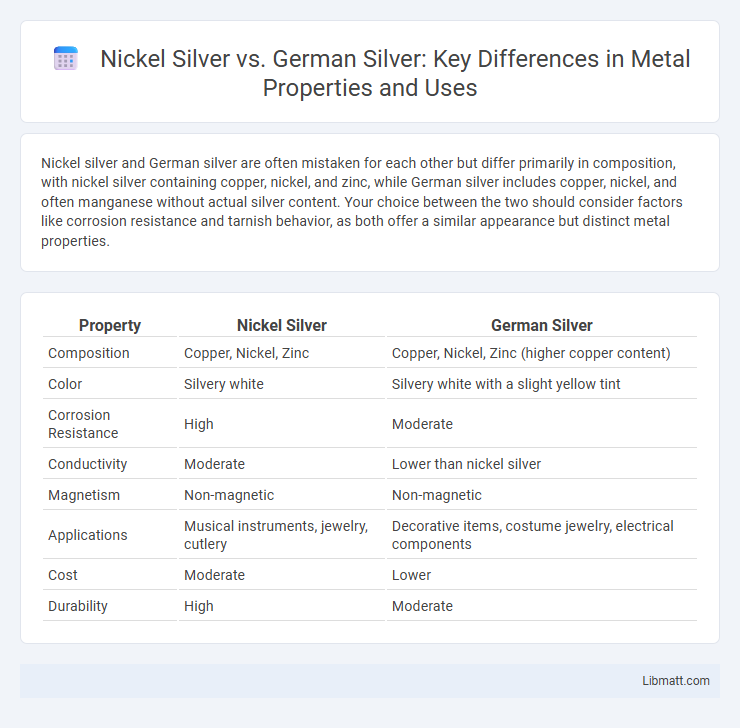Nickel silver and German silver are often mistaken for each other but differ primarily in composition, with nickel silver containing copper, nickel, and zinc, while German silver includes copper, nickel, and often manganese without actual silver content. Your choice between the two should consider factors like corrosion resistance and tarnish behavior, as both offer a similar appearance but distinct metal properties.
Table of Comparison
| Property | Nickel Silver | German Silver |
|---|---|---|
| Composition | Copper, Nickel, Zinc | Copper, Nickel, Zinc (higher copper content) |
| Color | Silvery white | Silvery white with a slight yellow tint |
| Corrosion Resistance | High | Moderate |
| Conductivity | Moderate | Lower than nickel silver |
| Magnetism | Non-magnetic | Non-magnetic |
| Applications | Musical instruments, jewelry, cutlery | Decorative items, costume jewelry, electrical components |
| Cost | Moderate | Lower |
| Durability | High | Moderate |
Introduction to Nickel Silver and German Silver
Nickel silver, also known as German silver, is an alloy composed primarily of copper, nickel, and zinc, known for its silvery appearance despite containing no actual silver. This versatile material is widely used in musical instruments, jewelry, and cutlery due to its corrosion resistance and durability. Understanding the subtle distinctions in composition and applications can help you choose the right alloy for your specific needs.
Origins and Historical Background
Nickel silver, also called German silver, originated in the early 19th century as an alloy of copper, nickel, and zinc designed to imitate sterling silver without containing any actual silver. The term "German silver" reflects its invention in Germany, where metallurgists developed it to create durable, corrosion-resistant items with a bright, silvery appearance. Despite the name, neither nickel silver nor German silver contain silver, distinguishing them from traditional silver alloys used in jewelry and tableware.
Composition and Material Differences
Nickel silver, often referred to as German silver, is an alloy primarily composed of copper, nickel, and zinc, but nickel silver specifically contains a higher percentage of nickel, typically around 10-20%, which gives it a distinct silvery appearance and enhanced corrosion resistance. German silver traditionally contains a balanced mix of roughly 60% copper, 20% nickel, and 20% zinc, resulting in a slightly different hue and mechanical properties. The key material difference lies in nickel silver's elevated nickel content, which improves durability and aesthetic qualities compared to the more varied compositions labeled as German silver.
Visual & Physical Properties
Nickel silver features a bright, silvery-white appearance with a smooth surface, while German silver exhibits a slightly warmer, more yellowish tone due to its higher copper content. Both alloys possess excellent corrosion resistance, but nickel silver is stronger and harder, making it more suitable for durable applications. German silver offers better machinability and malleability, allowing for intricate designs and fine detailing in decorative items.
Common Applications and Uses
Nickel silver is commonly used in musical instruments, jewelry, and cutlery due to its corrosion resistance and silver-like appearance. German silver, also known as nickel brass, finds applications in electrical connectors, precision instruments, and decorative items because of its excellent conductivity and durability. Understanding these uses can help you choose the right alloy for your specific project or product needs.
Durability and Maintenance
Nickel silver, an alloy of copper, nickel, and zinc, offers superior durability and corrosion resistance, making it ideal for everyday use with minimal maintenance. German silver, also known as nickel silver, shares similar composition but often contains varying nickel content, which can affect its hardness and tarnish resistance. Both materials require occasional polishing to maintain shine, but nickel silver generally demands less frequent upkeep due to its enhanced durability.
Corrosion and Tarnish Resistance
Nickel silver offers excellent corrosion and tarnish resistance due to its higher nickel content, making it ideal for items exposed to moisture and air over time. German silver, despite its name, contains no actual silver and is more prone to tarnishing and corrosion because of its copper and zinc composition. To maintain your items' appearance, nickel silver provides greater durability against environmental factors compared to German silver.
Cost and Availability Comparison
Nickel silver typically costs more than German silver due to its higher nickel content and increased corrosion resistance, making it a popular choice for jewelry and musical instruments. German silver, though similar in appearance, is generally more affordable and widely available for decorative and industrial uses because it contains less nickel and more copper and zinc. When considering your project budget, choosing German silver can reduce costs without compromising much on the visual appeal.
Health, Safety, and Allergic Considerations
Nickel silver contains nickel, a common allergen that can cause skin irritation or allergic reactions in sensitive individuals, making it less suitable for people with metal allergies. German silver, despite its name, contains no actual silver but is an alloy with copper, nickel, and zinc, and may still pose health risks due to the nickel content. To maintain your health and safety, choose nickel-free alloys or hypoallergenic alternatives when allergic reactions are a concern.
Which One to Choose: Nickel Silver or German Silver?
Nickel silver, composed primarily of copper, nickel, and zinc, offers superior corrosion resistance and a bright, silvery finish ideal for jewelry and musical instruments. German silver, also known as nickel silver, contains a higher copper content with similar nickel and zinc percentages but may tarnish more easily over time. When choosing between the two, consider your need for durability and aesthetic longevity, as your choice will impact the item's appearance and maintenance requirements.
Nickel silver vs German silver Infographic

 libmatt.com
libmatt.com